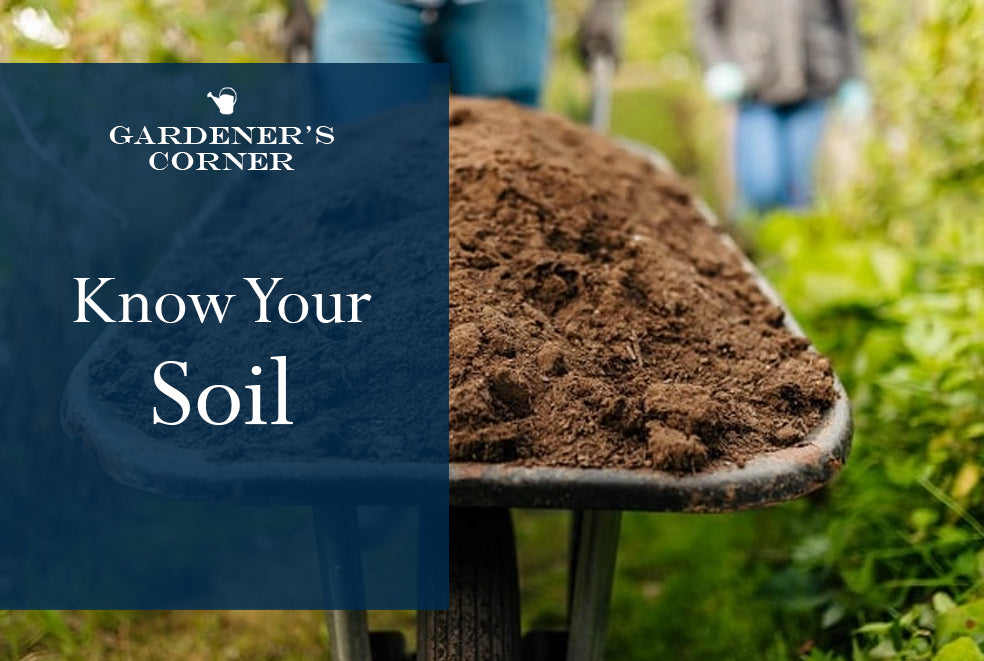What type of soil do you have?
Soil science is not the most exciting subject but vital for the health of your plants.

Sandy soil – Usually warm and dry it can be acidic. Sandy grains will sink and form a layer on the bottom of the jar. The water will also be quite clear. Sandy soils drain quickly but do not hold nutrients well.
Clay soil – a very dense soil cold and wet in the winter and dries out in the summer. The water stays cloudy with only a thin layer of dirt on the bottom, then you have clay-like soil. The water stays dirty because the clay particles are held in suspension.
Peat soil – very acidic if you have a lot of debris floating on the surface with a small amount of sediment on the bottom, then your soil may be peat-like. This also results in somewhat cloudy water. This soil is poor in nutrients and is prone to water logging.
Chalky soil – you will see a layer of white, gritty fragments at the bottom of the jar and the water will be a grey colour. This soil is alkaline. Prone to drying out and isn’t very nutritional for plants.
Silt / Loamy soil – Perfect soil, as it’s considered the ideal soil type and texture. You will see clear water with a layered sediment on the bottom, with the finest particles on the top.
Testing for pH
The acidity/alkalinity of soil is measured on a pH scale, (potential Hydrogen) which runs from 0 to 14. Neutral soil has a pH of 7. Alkaline (lime-rich) soil has a pH above 7, and the higher the pH, the more alkaline the soil. Chalky or limestone soils are alkaline. You can measure your soil pH using a simple testing kit. If you have alkaline soil, choose plants that will thrive in it – acid-loving or ericaceous plants such as rhododendrons will not. Club root disease (which affects brassicas) is less prevalent in alkaline soil.
Your soil can be professionally tested by contacting the RHS soil analysis service who will provide a full written report on your soil.
Home testing
You can test the pH of your soil by using a chemical soil check available in most garden centres, by using an electronic soil tester which will also test for moisture and light or use a simple litmus test.
Soil Acidity or Alkalinity: The Kitchen Soil pH Test
Place 2 tablespoons of soil in a bowl and add ½ cup vinegar. If the mixture fizzes, you have alkaline soil.
Place 2 tablespoons of soil in a bowl and moisten it with distilled water. Add ½ cup bicarbonate of soda. If the mixture fizzes, you have acidic soil.
If it does not react to either test, the soil has a neutral pH.
What do the results mean?
pH 3.0 - 5.0
- Very acid soil
- Acid sandy soils are often deficient in trace elements.
- Add lime to raise the pH to above 5.0. The addition of lime can help break up acid clay soils
Very few plants can grow in these conditions. Organic material cannot rot below pH4.7
pH 5.1 - 6.0
- Acid soil
- Action: Add lime if other plants are grown
Ideal for ericaceous (lime-hating) plants such as rhododendrons , camelias and heathers
pH 6.1 - 7.0
- Moderately acid soil
- A pH 6.5 is the best general purpose pH for gardens, allowing a wide range of plants to grow, except lime-hating plants
- The availability of major nutrients is at its highest and bacterial and earthworm activity is optimum at this pH
A pH 6.5 is the best general purpose pH for gardens, allowing a wide range of plants to grow, except lime-hating plants
pH 7.1 - 8.0
- Alkaline soil
- Phosphorus availability decreases
- Iron and manganese become less available leading to lime-induced chlorosis
- Sulphur, iron sulphate and other acidifying agents can sometimes be added to reduce pH.
An advantage of this pH level is that clubroot disease of cabbage family crops (brassicas) is reduced.
Clay soils often require very large amounts of acidifying material and soils with free chalk or lime are not usually treatable.

